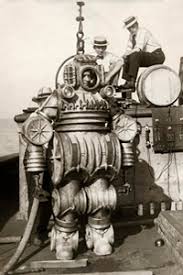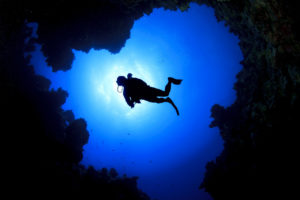Summary: This section examines how human anatomy correlates to human’s enhanced ability explore the ocean’s mysterious depths. It explores how early diver troubleshooting and how experimentation led to innovative solutions. This chapter explains that microscopic bubbles in the blood, between joints, and other key areas cause problems and pain risk the diver’s life. The section also touches on the interactions between water outside the body and liquids and gases within the body, inherently altering metabolic processes with long-lasting effects.
Bubbles in blood
“The bends,” or itchy skin and severe limb pain, occurs when compressed air decompresses and blood and tissue gas escapes.  Blood bubbles grow and block finer blood vessels, preventing blood flow to tissues and causing profound cell death, clots, and tissue disruption. The “chokes” refer lungs bubbles that cause difficulty breathing. The “staggers” result from inner ear bubbles impairing balance. The “bends” stem from bubbles in joints, and in more severe cases in the spinal cord that cause pins and needles. To escape the problem of the “bends,” scientists slow decompression rapid descent and gradual ascent.
Blood bubbles grow and block finer blood vessels, preventing blood flow to tissues and causing profound cell death, clots, and tissue disruption. The “chokes” refer lungs bubbles that cause difficulty breathing. The “staggers” result from inner ear bubbles impairing balance. The “bends” stem from bubbles in joints, and in more severe cases in the spinal cord that cause pins and needles. To escape the problem of the “bends,” scientists slow decompression rapid descent and gradual ascent.
Skin Diving and the Bends
Without recompression after symptom onset, skin divers experience loss of conscious, paralysis, and even death. Pearl divers in the South Pacific experiencing these symptoms fell victim to the “bends” as they continually dove and resurfaced rapidly, not allowing enough time for the nitrogen dissolved in their tissues to escape. Others, like the Ama of Japan, dove to collect Japanese delicacies but rarely contracted the “bends.” Women tend to be better divers since they can hold their breath longer and resist the cold longer.
Entering the water
Upon immersion up to the neck, external water pressure forces blood upward and distends the great veins, increasing cardiac output. Exiting the water, however, one’s lower limbs have not received ample blood flow and thus may cause individuals to collapse and undergo cardiac arrest. As such, rescue extraction from the sea is horizontal.
Imploding and Exploding Organs
Bodily gases occupy small volume and experience extreme pressure under water. Trying to inhale from under a meter of water remains virtually impossible due to external chest pressure and resistance within the tube.  Ascending with full lungs tempts lung explosion since air will dramatically expand under less pressure. Ear pain stems from trapped air in the middle ear. To prevent implosion, the throat must connect to the middle ear, which is done by pinching your nose and blowing it. Brain damage can also occur under major pressure.
Ascending with full lungs tempts lung explosion since air will dramatically expand under less pressure. Ear pain stems from trapped air in the middle ear. To prevent implosion, the throat must connect to the middle ear, which is done by pinching your nose and blowing it. Brain damage can also occur under major pressure.
Holding Breath
A diver becomes denser further down as air is compressed. On the ascent, the pressure decreases and the diver is again buoyant. To maximize the time spent holding breath, rapid hyperventilation must first occur to push out remaining carbon dioxide.
Rapture of the deep
“…Scuba divers have been known to offer their mouth-pieces to passing fish.”
Nitrogen causes elation, perceived mental agility, detachment from reality, motor agility loss, and irrational behavior. Nitrogen intoxication mimics alcohol-like effects and poses a danger when prolonged and untreated. Like alcohol, one’s nitrogen tolerance improves with exposure, allowing for deeper dives without these effects.
Long-term dangers
Disabling pain in joints due to bone necrosis overlaps with where gas bubbles build up near the joints. The damage correlated to the depth, with extensive pain and deterioration occurring in seasoned divers. Divers also suffer from long-term hearing loss. It is unclear whether neurological damage occurs directly from diving.

